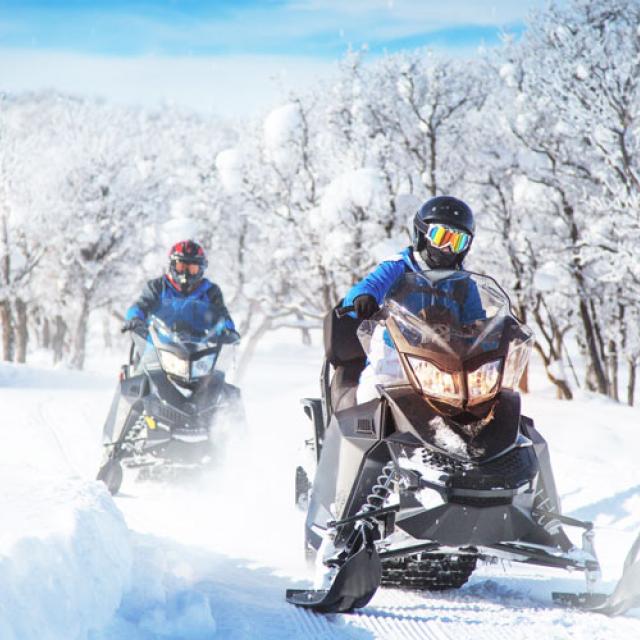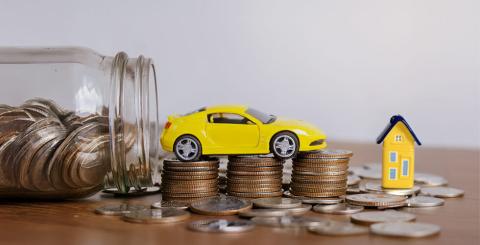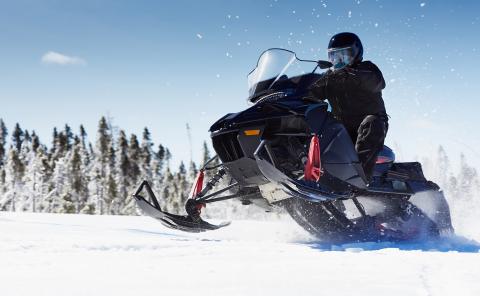Electric snowmobiles 101

Did you know that the world’s first electric snowmobile was built in Shawinigan, Québec? Now there’s something to be proud of! The three Québec engineers behind Taiga Motors had plenty of challenges to tackle, including resistance to subzero temperatures and battery autonomy. Their goal? To build a high-performance vehicle that could compete with gas-powered models while remaining environmentally friendly.
The Taiga TS3 is now available for preorder and is sure to turn heads among snowmobilers and car buffs alike. Here’s a closer look at this local innovation—from powertrain technology to how it stacks up against traditional snowmobiles.
How does it work?
The Taiga’s battery is recharged by regenerative braking, just like an electric car. When the rider applies less than 40% of the full brake power, the motor converts the vehicle’s momentum into electricity. That energy is fed back into the battery, recharging it while you ride.
Depending on the model and manufacturer, lithium-ion electric batteries range from 21 kWh to 28 kWh. A full charge takes 20 minutes at a fast station and up to 2 hours at an EV charging station. You can even recharge the Taiga on a regular residential outlet, as long as you’re patient. The full charge time is 10 whole hours!
Taiga Motors claims the battery won’t lose more than 5% of its charge, even in the extreme cold. Pretty impressive!
Electric vs. gas
Find out what separates them beyond their engines and whether electric sleds come out on top. Let’s dive right in.
Autonomy: The Taiga has a range of 100 to 140 km, depending on your driving style. A high-performance gas snowmobile can easily go up to 300 km on a full tank.
Maximum speed: Gas and electric sleds max out at similar speeds. The Taiga goes up to 110 km/h (160 km/h in perfect conditions) and unmodified gas sleds top out around 120 km/h. But the maximum speed limit in Québec is 70 km/h, so both options have more than enough pep!
Powertrain: Taiga claims its electric motor is capable of generating more torque than the most efficient combustion engines—about 510 kg of raw pulling power. Plus, the engine is impervious to external factors like cold weather, elevation, and driving style.
Acceleration: The Taiga does 0 to 100 km/h in about 3 seconds. It clearly wins out over the average gas engine, which does 0 to 100 km in 4 to 6 seconds.
Preheating: Electric motors need to warm up, so the Taiga requires a bit more patience. It takes about 6 minutes to preheat the battery from -30°C, compared to about 1 minute for a gas snowmobile. Some snowmobilers forget to warm up their engines—a big mistake!
Noise: Noisy gas engines are probably the number one source of complaints for snowmobilers. Gas engines are just plain loud, even when they’re sealed under the hood. The Taiga is much quieter.
Weight: With its lithium-ion battery, the Taiga is heavier than a gas sled, tipping the scales at 500 lbs. vs. 420 lbs. for many two-stroke gas snowmobiles.
Environmental impact: The Taiga doesn’t emit any greenhouse gases, so it’s obviously a much more environmentally friendly option. Late-model snowmobiles are a clear improvement over models from 15 years ago. They emit only half as much carbon monoxide and volatile compounds.
Price: At $20,000 for the base model, electric sleds are a bit more expensive than standard gas models. Not surprising given that it’s a new technology.
As they continue to evolve and the industry adapts to electric snowmobiles, the price difference will probably erode.
Some things never change
There are a few constants, whether you’re riding a gas or an electric sled. For example, the are the same:regulations are the same:
- You must always have the following documents with you when riding:
- Proof of liability insurance
- Vehicle registration certificate
- ID showing your age
- Valid driver’s licence (for all off-road vehicle drivers)
- Training certificate for drivers ages 16 and 17
- You can be fined and lose demerit points if you commit a violation under the Highway Safety Code or the Act respecting off-highway vehicles while operating a snowmobile.
- Speed limit:
- 70 km/h, unless otherwise indicated
- 30 km/h within 30 m of a residence
- The restrictions on your driver’s license and the penalties under the law are the same, no matter what type of vehicle you’re operating.
- You must always wear a helmet.
- You must have a valid permit when riding on trails maintained by off-road vehicle clubs.
And is always a must! Snowmobilers need a minimum of $1,000,000 in liability insurance to cover bodily harm and property damage to third parties caused by their snowmobiles. Fines for failure to comply with the insurance regulations are steep. It’s another good reason to check out our article on what to look for in snowmobile insurance before hitting the trails! snowmobile insurance is always a must! Snowmobilers need a minimum of $1,000,000 in liability insurance to cover bodily harm and property damage to third parties caused by their snowmobiles. Fines for failure to comply with the insurance regulations are steep. It’s another good reason to check out our article on FCMQ ). Happy shopping and enjoy the winter!




